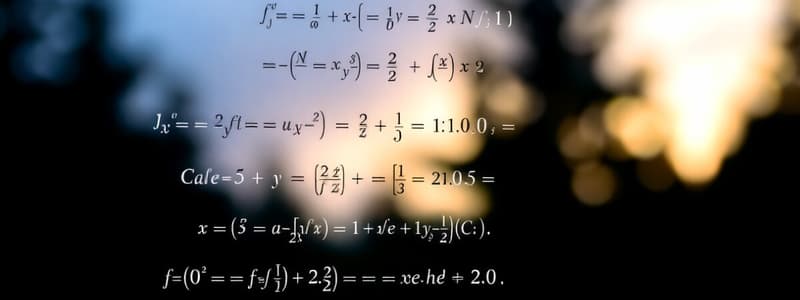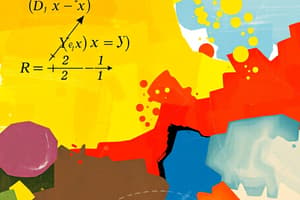Podcast
Questions and Answers
What is the correct definition of the derivative of a function?
What is the correct definition of the derivative of a function?
- The value of the function at a specific point.
- The slope of the secant line between two points on the curve.
- The limit of the average rate of change of the function as the interval approaches zero. (correct)
- The integral of the function over a specified interval.
What does the Power Rule state regarding differentiation?
What does the Power Rule state regarding differentiation?
- The derivative of a function raised to the power n is n times the function raised to the power n-1. (correct)
- The derivative of a product of two functions is their product multiplied by their derivatives.
- The derivative of a constant is always one.
- The derivative of a function divided by another function is the quotient of their derivatives.
Which notation is used to denote the derivative in Leibniz notation?
Which notation is used to denote the derivative in Leibniz notation?
- dy/dx (correct)
- f'(x)
- Df(x)
- f''(x)
When using the Product Rule, which of the following correctly describes the formula?
When using the Product Rule, which of the following correctly describes the formula?
What condition indicates a function is concave up?
What condition indicates a function is concave up?
Which statement is true regarding critical points?
Which statement is true regarding critical points?
In terms of motion analysis, what does the derivative represent?
In terms of motion analysis, what does the derivative represent?
Which of the following is the derivative of the function $e^x$?
Which of the following is the derivative of the function $e^x$?
What does the second derivative of a function indicate?
What does the second derivative of a function indicate?
Which of the following correctly applies the Quotient Rule to the functions u(x) and v(x)?
Which of the following correctly applies the Quotient Rule to the functions u(x) and v(x)?
What is required for a function to be differentiable at a specific point?
What is required for a function to be differentiable at a specific point?
According to the Mean Value Theorem, what can be concluded about a function that is continuous on [a, b] and differentiable on (a, b)?
According to the Mean Value Theorem, what can be concluded about a function that is continuous on [a, b] and differentiable on (a, b)?
If a function's first derivative equals zero at a certain point, what does this typically indicate?
If a function's first derivative equals zero at a certain point, what does this typically indicate?
In the chain rule, if y = f(g(x)), how is dy/dx calculated?
In the chain rule, if y = f(g(x)), how is dy/dx calculated?
Which notation represents the nth derivative of a function?
Which notation represents the nth derivative of a function?
What does the notation df/dx represent?
What does the notation df/dx represent?
Flashcards are hidden until you start studying
Study Notes
Differential Calculus
-
Definition
- Branch of calculus that deals with the rate of change of functions.
- Primarily concerned with derivatives and their applications.
-
Derivative
- The derivative of a function ( f(x) ) at a point ( x ) is the limit of the average rate of change as the interval approaches zero: [ f'(x) = \lim_{h \to 0} \frac{f(x+h) - f(x)}{h} ]
- Represents the slope of the tangent line to the curve at that point.
-
Notation
- ( f'(x) ) (Lagrange notation)
- ( \frac{dy}{dx} ) (Leibniz notation)
- ( Df(x) ) (Newton's notation)
-
Rules of Differentiation
- Power Rule: [ \frac{d}{dx}(x^n) = nx^{n-1} ]
- Product Rule: [ \frac{d}{dx}(uv) = u'v + uv' ]
- Quotient Rule: [ \frac{d}{dx}\left(\frac{u}{v}\right) = \frac{u'v - uv'}{v^2} ]
- Chain Rule: [ \frac{dy}{dx} = \frac{dy}{du} \cdot \frac{du}{dx} ]
-
Higher Order Derivatives
- The second derivative ( f''(x) ) is the derivative of the derivative ( f'(x) ).
- Higher derivatives can be denoted as ( f^{(n)}(x) ).
-
Applications of Derivatives
- Finding Tangents: Slope of the tangent line at a point.
- Optimization: Finding local maxima and minima using the First and Second Derivative Tests.
- Curve Sketching: Analyzing increasing/decreasing intervals and concavity.
- Motion Analysis: Relating the derivative to velocity and acceleration in physics.
-
Critical Points
- Points where ( f'(x) = 0 ) or ( f'(x) ) is undefined.
- Important for determining local maxima and minima.
-
Concavity and Inflection Points
- Concave Up: ( f''(x) > 0 ) indicates the function is curving upwards.
- Concave Down: ( f''(x) < 0 ) indicates the function is curving downwards.
- Inflection Point: Points where concavity changes, found where ( f''(x) = 0 ) or undefined.
-
Special Functions
- Trigonometric, logarithmic, and exponential functions have specific differentiation formulas.
- Example:
- ( \frac{d}{dx}(\sin x) = \cos x )
- ( \frac{d}{dx}(e^x) = e^x )
- ( \frac{d}{dx}(\ln x) = \frac{1}{x} )
- Example:
- Trigonometric, logarithmic, and exponential functions have specific differentiation formulas.
These notes provide an overview of key concepts and techniques in differential calculus, essential for understanding more complex calculus topics and their applications.
Differential Calculus
-
It's a branch of calculus focusing on the rate of change of functions.
-
Derivatives are the primary focus, representing the instantaneous rate of change at a specific point.
Finding Derivatives
-
The derivative of a function (f(x)) at (x) is found by taking the limit of the average rate of change over an interval approaching zero:
[ f'(x) = \lim_{h \to 0} \frac{f(x+h) - f(x)}{h} ]
-
This derivative represents the slope of the tangent line to the curve at that point.
Derivative Notations
-
( f'(x) ) is called Lagrange notation.
-
( \frac{dy}{dx} ) is known as Leibniz notation.
-
( Df(x) ) is called Newton's notation.
Differentiation Rules
-
Power Rule: For any power (n), ( \frac{d}{dx}(x^n) = nx^{n-1} ).
-
Product Rule: For functions (u) and (v), ( \frac{d}{dx}(uv) = u'v + uv' ).
-
Quotient Rule: For functions (u) and (v), ( \frac{d}{dx}\left(\frac{u}{v}\right) = \frac{u'v - uv'}{v^2} ).
-
Chain Rule: For a composite function (y = f(u)) where (u = g(x)), ( \frac{dy}{dx} = \frac{dy}{du} \cdot \frac{du}{dx} ).
Higher Order Derivatives
-
The second derivative (f''(x)) is the derivative of the first derivative (f'(x)).
-
Higher derivatives can be denoted as (f^{(n)}(x)).
Applications of Derivatives
-
Finding Tangents: The derivative directly gives the slope of a tangent line to the function at any given point.
-
Optimization: The first and second derivative tests help find local maxima and minima, crucial for optimization problems.
-
Curve Sketching: Derivatives tell us where a function is increasing or decreasing, and its concavity (whether it curves upward or downward).
-
Motion Analysis: Derivatives are used to define velocity (rate of change of position) and acceleration (rate of change of velocity) in physics.
Critical Points
- These occur when (f'(x) = 0) or (f'(x)) is undefined.
- They are pivotal for determining local maxima, minima, and inflection points.
Concavity and Inflection Points
-
Concave Up: (f''(x) > 0) means the function is curving upwards.
-
Concave Down: (f''(x) < 0) means the function is curving downwards.
-
Inflection Point: When the concavity changes, found where (f''(x) = 0) or undefined.
Special Functions
- Trigonometric, logarithmic, and exponential functions have specific differentiation formulas.
- Some examples:
- ( \frac{d}{dx}(\sin x) = \cos x )
- ( \frac{d}{dx}(e^x) = e^x )
- ( \frac{d}{dx}(\ln x) = \frac{1}{x} )
Knowing these concepts and rules is essential for navigating more complex calculus topics and their applications in real-world scenarios.
Differential Calculus
- Differential Calculus deals with the study of rates at which quantities change.
- Focuses on the concept of the derivative.
- Derivative represents the rate of change of a function concerning its variable.
Key Concepts
- Derivative is denoted as f'(x) or df/dx.
Notation
- Leibniz Notation: df/dx
- Lagrange Notation: f'(x)
- Newton Notation: ẋ (when time is the variable)
Basic Rules for Differentiation
- Power Rule: If f(x) = x^n, then f'(x) = n * x^(n-1).
- Product Rule: (uv)' = u'v + uv'
- Quotient Rule: (u/v)' = (u'v - uv') / v^2
- Chain Rule: If y = f(g(x)), then dy/dx = f'(g(x)) * g'(x)
Higher Order Derivatives
- Second Derivative: f''(x) or d²f/dx², indicates a function's concavity.
- n-th Derivative: f^(n)(x) or d^nf/dx^n, represents the derivative taken n times.
Applications of Derivatives
- Tangent Lines: The derivative at a point gives the slope of the tangent to the curve at that point.
- Optimization: Derivatives are used to find local maxima and minima by setting f'(x) = 0.
- Motion problems: Derivatives describe velocity and acceleration in physics.
Critical Points
- Points where the derivative is either zero or undefined.
- Determine local extrema through the First and Second Derivative Tests.
Continuity and Differentiability
- A function must be continuous at a point to be differentiable there.
- A differentiable function can have sharp turns or cusps where the derivative does not exist.
Differential Equations
- Equations that involve derivatives of functions are used to model real-world phenomena.
Limit Definition of Derivative
- f'(a) = lim (h → 0) [(f(a + h) - f(a)) / h]
Important Theorems
- Mean Value Theorem: If a function is continuous on [a, b] and differentiable on (a, b), then there's at least one point c in (a, b) where f'(c) = (f(b) - f(a)) / (b - a).
- Rolle's Theorem: If f(a) = f(b), then there's some c in (a, b) such that f'(c) = 0.
Studying That Suits You
Use AI to generate personalized quizzes and flashcards to suit your learning preferences.




